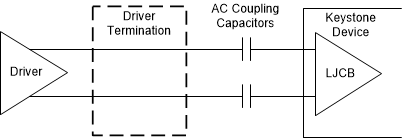SPRACL9 May 2019 66AK2E05 , 66AK2H06 , 66AK2H12 , 66AK2H14 , AM5K2E02 , AM5K2E04 , TMS320C6652 , TMS320C6654 , TMS320C6655 , TMS320C6657 , TMS320C6670 , TMS320C6671 , TMS320C6672 , TMS320C6674 , TMS320C6678
- KeyStone Multicore Device Family Schematic Checklist
5.2.3 LJCB Differential Clock Inputs
- Many reference clock inputs are connected to a low-jitter clock buffers (LJCB) in the KeyStone devices. This buffer is designed to interface with LVDS, LVPECL, and HCSL clock input levels using AC coupling capacitors.
- The LJCB has internal termination and an internal common mode voltage generator so no external termination is needed between the AC coupling capacitors and the KeyStone device.
- The driver selected for your design may require termination on the output. You should review the device-specific data manual for the driver to determine what termination is necessary.
 Figure 1. LJCB Differential Clock Inputs
Figure 1. LJCB Differential Clock Inputs